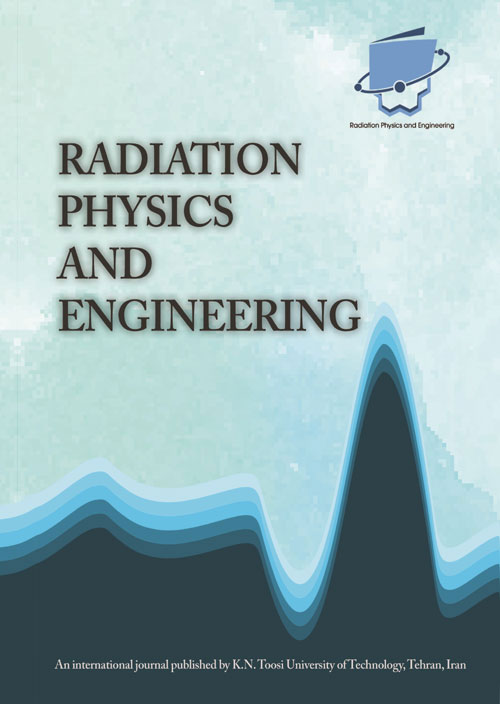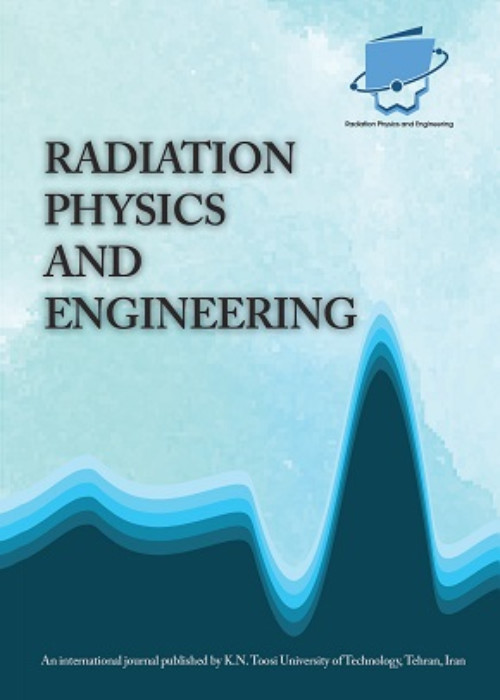فهرست مطالب

Radiation Physics and Engineering
Volume:3 Issue: 2, Spring 2022
- تاریخ انتشار: 1401/02/19
- تعداد عناوین: 6
-
-
Two-dimensional modeling of atmospheric-pressure cold plasma jet generator for treatment applicationPages 1-6In this study , cold atmospheric pressure plasma jet used in treatment application was studied using COMSOL Multiphysics with the Finite Element Method . The device operates with argon gas at atmospheric pressure and by an alternating current power supply . Effective plasma parameters for treatment such as electron density and electron temperature and electrical potential have been investigated . Plasma parameters that affect treatment were determined by establishing a virtual laboratory before the experiment . The electron density value is suitable for therapeutic applications and The plasma temperature is less than the amount that the tissue is damaged . The gas inside the jet is argon and the flow rate is 5 slm . the pressure of the dielectric barrier discharge type of plasma jet is kept 1 atmosphere . The frequency of the electrodes is kept constant at 25 kHz and their Maximum voltage at 9 kV .Keywords: DBD jet generation, two-dimensional simulation, cold plasma, Amospheric pressure, COMSOL Multiphysics
-
Pages 7-10In this research work, powder hydroxyapatite samples were synthesized using a solid-state reaction method to investigate the annealing effect. The crystal structure was carried out by XRD system produced data, and the Rietveld method using MAUD software. The samples were irradiated in different radiation absorbed doses up to 1500Gy and their thermoluminescence properties including glow curve, response, fading effect and reproducibility were investigated from dosimetry point of view. The results showed that the annealing temperature significantly affects the crystal structure and thermoluminescence dosimetry response of hydroxyapatite samples, consequently. It was concluded that high temperature annealing process can lead to formation of β-TCP crystal phase during the synthesis of hydroxyapatite. Percentage of this formed phase increases with rising the temperature, and finally leads to increasing of the thermoluminescence response. It was concludded that in the solid state reaction method to increasing the TL response, it is better to use high annealing temperature for the synthesis of hydroxyapatite sample.Keywords: Hydroxyapatite, Solid state, Thermoluminescence, Dosimetry, Rietveld refinement
-
Pages 11-15In this experimental work, Polycarbonate/Bismuth Oxide (PC-Bi2O3) nanocomposites were prepared in various concentrations of 0, 10, 30, and 50 wt% with thicknesses of 1 mm and irradiated by a pure beta-emitter source of Sr-90. To fabricate the electrodes, copper sheets with thickness of 100 µm were attached to the top and bottom surfaces of the samples using the silver paste. Then, electric current as the dosimetry response, was measured at various dose rates ranging from 30-102 mSv.h-1 at a fixed voltage of 400 V using an electrometer. Results showed that increasing the Bi2O3 wt% led to improvement in the dosimetry response linearly at various dose rates. Also, the amounts of sensitivities for the samples of 0, 10, 30, and 50 wt% were measured as 20.3, 19.8, 28.6, and 36.7 nC.mSv-1.cm-3, respectively. Regarding the mechanism of beta interaction with a polymer-heavy metal oxide nanocomposite, the Bremsstrahlung radiation can be considered as a dominant effect.Keywords: Beta-ray Dosimeter, PC-Bi2O3 nanocomposite, Dose rate, Strontium-90, Sensitivity
-
Pages 17-25Two main insulating gases of SF₆ and N₂/CO₂ mixture are employed to increase voltage capability of electrostatic accelerators. SF₆ offers more insulating capability, but environmental and technical disadvantages of SF₆ makes usage of N₂/CO₂ mixture a desirable option. This paper aims to replace SF₆ with N₂/CO₂ in design of a 500 kV/30 mA parallel-fed voltage multiplier. High-voltage section of the accelerator is a capacitive structure which in combination with rectifying elements, generates the accelerating high-voltage. The structure which is called Voltage Multiplier Capacitive Structure (VMCS) is designed and analyzed in this paper. The first structure is designed to employ SF₆ as insulating gas (VMCS500). Then, the structure is modified to be capable of using N₂/CO₂ as insulating gas with lower breakdown voltage (VMCS500-m). The modified structure requires more complex mechanical manufacturing process, but offers the simplicity of using N₂/CO₂ mixture, the option of using the modified structure with superior SF₆ gas, increasing the output voltage and beam energy. CST EM STUDIO was used for capacitance calculation and electric field analysis. LTSPICE was used for equivalent circuit analysis of the high voltage generating section.Keywords: Accelerator, Electrostatic, high-voltage, cascade generator, insulating gas
-
Pages 27-30
In the present work performance of film badge as an alternative personal dosimeter for thermal neutrons is investigated. To do this, a cadmium-lead (Cd-Pb) filter with the same thickness as the tin-lead (Sn-Pb) filter is attached to the AERE/RPS badge. Since thermal neutrons are mixed with gamma rays, the dosimeter is irradiated by the 60Co gamma rays standard field of Karaj Secondary Standard Dosimetry Lab as well as the mixed neutron-gamma field of the radiography beamline of Isfahan Miniature Neutron Source Reactor. In the both fields, ten personal dose-equivalent values between 0.1 to 10 mSv are chosen. For any dose, three film badges are used and the net optical density is determined as the average of their optical densities. Finally, the calibration curves of the film badge are plotted to determine the dose-equivalent values. Obtained results reveal that film badge simultaneously determines the thermal neutrons and gamma rays dose fractions. Also, the thermal neutron doses are at most 50% different from the nominal values considered.
Keywords: Film badge, Thermal neutron, MNSR, Personal dosimetry -
Pages 31-36After some accidents like TMI and Fukushima Daiichi, the belief that nuclear fuels can safely and reliably be used up to 65 MW.d/kgU was revised. Different short to long term concepts started to be assessed more seriously. Among these concepts, Cr-coated Zr cladding tubes were taken into consideration as a promising remedy for the short term perspectives. Various efforts to evaluate important aspects of such designs (including coating methodologies, full size coating of cladding tubes, performance analysis, licensing features and so on) have been implemented and some activities are yet under accomplishment. In this study, an optimized cathodic arc PVD coating condition, from the defect density point of view, for applying Cr and CrN coating layers up 10 microns on typical VVER-1000 cladding tubes (Zr-1%Nb alloy) have been obtained. SEM results approved improvements, and furthur modification has been postponed till the finalizing the performance examinations in normal operational and accidental conditions (specifically, LB LOCA condition). Additionally, the list of required test, from characterizations to mechanical and performance experiments, in order to qualify the applicability of such coated samples are suggested.Keywords: Accident Tolerant Fuels (ATFs), Coated cladding tubes, Zr-1%Nb, ARC-PVD


